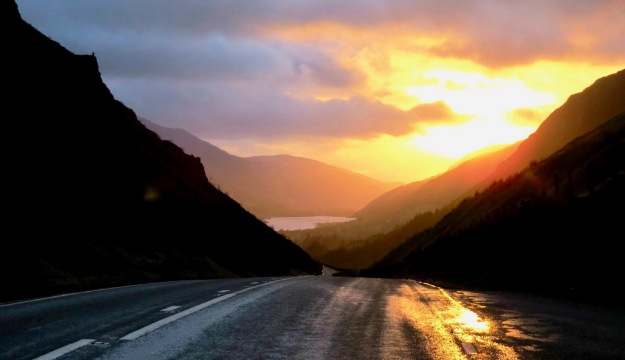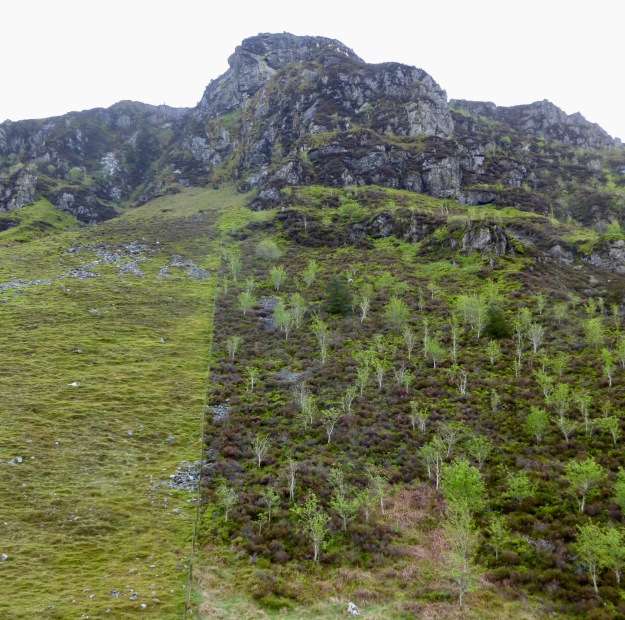Just above the busy A487 under the southern slopes of Cadair Idris is a remarkable fragment of countryside, which I had been meaning to take a closer look at for 20 years or more. I parked in the layby at the top of the pass; it was already half full with cars. Trudging up the slope towards the ridge-top was a straggle of dressed-to-kill hikers and a few rather more utilitarian plane spotters who carried shopping bags and windbreaks. I was heading to the other side of the valley – definitely ‘the road less travelled’.
It was a sunny February day, forecast to hit thirteen degrees, but I quickly realised that wasn’t going to apply to me. This side of the valley was in deep shade and I was soon reaching for my gloves. Gaining access through a disused quarry I clambered onto the steep slope under Craig y Llam and plunged unsteadily into the waist high heather and bilberry. Ahead of me for about a mile, parallel with the road, was a glimpse of what upland Wales might look like if we walked away and left nature to get on with it.
This must always have been a difficult place: steep scree – the fractured clitter still visible in places – with treacherous stream gullies bisecting the slope, all boxed in by dripping crags above and the road below. There can’t ever have been much forage for sheep here, but that wouldn’t have stopped them. Then this wild jumble of a slope was fenced out so the sheep were (more or less!) excluded. This has been the situation for the 35 years I have been passing this way, but it might be twice as long as that.
The consequence of this absence has been a prolific growth of heather and, even more striking, thousands of small rowan trees. Ominously there is also a scattering of young conifers and a few rhododendrons, but it is the rowans that take my eye, their gleaming shrink-wrapped bark give a cheerful gloss to the dour heather. These trees must have originated from berries spread by birds but by now the older ones are producing berries of their own and giving rise to new saplings. That they survive and grow here at all is a testament to their tenacity as there can be precious little soil amongst the splintered scree. Those other pioneer trees, birch and sallow, seem to be absent; perhaps the conditions are too harsh for them. Some of these rowans must be 50 years old but they are no more than six feet tall: squat and thickset, hunkered down for the long haul. Goodness knows if they will ever become proper woodland or remain like a scattering of un-awakened Ents.
The going is hard across the slope: a combination of steepness, invisible rocks underfoot and deep vegetation means I struggle to make any headway, twice collapsing in ungainly slow motion on to a cushion of heather. It looked much easier from the car. There is a debate amongst upland conservationists about what would happen to heather if you didn’t subject it to the usual treatment of burning, cutting and grazing. This place provides some of the answers. The heather is a mixture of tall healthy looking plants and a percentage of dead ones, bleached as bones; which is more or less what you would expect in a natural situation. Whether any younger plants are being recruited is difficult to say as the heather is embedded in a deep carpet of moss over rocks that disguises the size and age of the plants. Much of the moss is bronze and brilliant green Sphagnum (bog moss), which hints at the high levels of precipitation in this often mist shrouded pass. Sphagnum on a well drained, peat free slope is only possible if it rains a great deal. The contrast between all this prolific growth and the sheep nibbled hillsides is most vivid at the top of the pass where a fence divides the two, illustrating the ecological history of the Welsh uplands in a single snapshot.
The cumulative effect of the rock, moss, heather and stunted trees are somehow primeval. Despite the swish and rumble of the traffic on the road below this place seems outside of time, empty and indifferent; a glimpse of post-apocalyptic Wales. The only birdlife I hear is a ticking wren buried somewhere in the rocks above me. This is a place where ring ouzels nest but they will only be setting out from their winter quarters in Morocco about now. Peregrines also nest on the crags in this valley, but most likely high up on the other side – which is enviably bathed in warm sunshine this morning. In fact the other side with its closely cropped turf and topiaried gorse clumps looks like the Wales everyone expects; altogether more friendly than the dark anarchy on this side of the tracks.
After a couple of hours I give up and inelegantly scramble down to the road; better to risk the traffic than head back across that leg breaking terrain. The layby is full now and I can see the plane spotters high up on the ridge waiting for the fighter jets to come hurtling through the pass, their roar an intimation of Armageddon.
J



What an interesting contrast between the sheep-cropped grass on the one side of the fence and the richness of the wild, heathered land on the other. Thank you for sharing.
I felt transported to those steep slopes of the pass through your description and wished I’d been scrabbling through the heather at your side! I also found the ‘before the haircut’ and ‘after the haircut’ photograph, fascinating!
Fascinating! Sounds like a great place – and a valuable case study. I wonder if anyone is studying these “neglected” places.